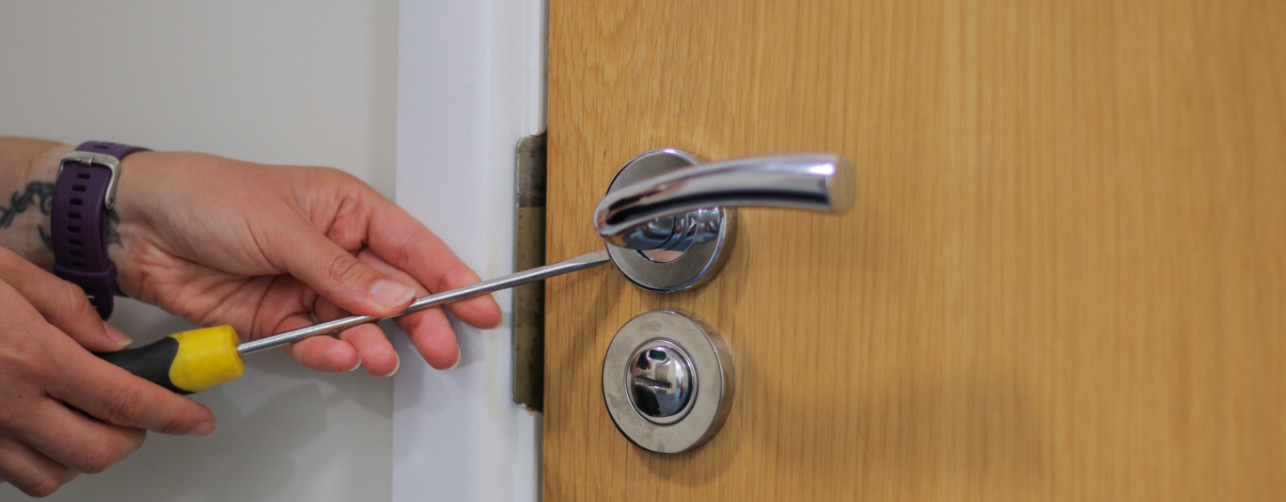 Add My Company
Add My Company

Drooping levers? Damaged handle? Latch bolt not retracting properly? Updating the design or finish of handles? Renovating a property? Change of use from a latch to a lock or vice versa?
Whatever the reason for changing your operating furniture, you’ll need to remove the original door handles first.
- Use a flat head screwdriver to pop off the push on rose.
There is a small slot, usually positioned on the underside of the cover plate. It should easily pop off and separate from the sub plate, giving access to the fixings beneath. Repeat on both sides of the door. Either remove the loose cover plates completely or leave them hooked over the lever so they’re not misplaced.
- Unscrew and remove the grub screw using an Allen key.
This loosens the handles from the spindle.
- Remove all wood screws and bolt through fixings.
Do this on both sides of the handle. This releases the rose sub plates from the face of the door. If you’re refitting the same pair of handles, hold onto all fixings to reinstall later.
- Pull the lever handles horizontally away from the face of the door.
As the spindle is still inside the latch mechanism the handles must be pulled straight, in opposite directions, not at an angle.
- Remove the spindle from the door and you’re done.
Some door handles or door knobs have the spindle fixed into one half of the pair whereas others have loose spindles that aren’t fixed to either handle. The door latch should remain in place as the latch plate is fixed in position from the forend.
In this example, we have used the ARRONE AR961 safety lever handle on round push on rose. You can see how to install this same handle on our blog or our YouTube channel. Whether fitting or removing, the door needs to be held open so use a door stop or wedge to hold it in position while you work.
It is worth noting that in the UK, some door knobs or handles are face fixing, some have a screw on rose, and others have grub screw fixed roses. So it is best to check which type you have before you remove the plates as the technique may differ slightly.
Removing the Locking Mechanism
Removing a door handle is quicker than fitting one, especially if you don’t also need to remove the latch or lockcase from the edge of the door. If you do need to change the door lock, you’ll have to remove the handles first. This is because the spindle and bolt through fixings run through the lockcase into each handle.
Remember to remove the strike plate from the door frame, as well as the components in the door. And, if it’s a cylinder lockcase you’d need to remove the screw that holds the cylinder in place before it can be removed. You can watch one of our Tool Box Talks videos below to see how to remove a cylinder from a mortice lockcase.
What Now? Replacing a Door Handle
After those 5 quick steps, your existing door handle has been removed. Whether it was taken off to repair or refinish the door, or a replacement door was being installed it’s time to replace your door handles. The same handles could be easily put back on, as we mentioned above, or a different pair of levers or door knobs could be installed.
When replacing door handles consider the following where applicable:
- Rose or backplate design
- Size and shape of rose or backplate
- Will any existing fixing holes be covered
- Are fixings in the same or different positions
- Type and location of fixings for handle and any cover plate
- Handle function - latch, bathroom, lock
- If using a sashlock, do the centre measurements align
- Backset from the edge of the door
- Any accessibility criteria e.g. compliance with BS 8300 dimensions
- Depth of rose/backplate and length of cylinder lock barrel
- Length of spindle
- Filling required post-installation to cover fixing holes
- Suitability for fire rated doors
- Internal or external use
- Matching finish to other door hardware
- Corrosion resistance - to harsh cleaning materials or environments e.g. swimming pools
There is also the use of the door to consider - if it’s a high traffic area it could be that a pull handle is easier for users than a lever handle. Plenty to consider for something so unassuming.
Our customer services team are on hand for any product queries - suitability, fitting, removal, trouble shooting, price and availability, compliance and best practice. Contact us today if you need any help with your ironmongery or door control solutions: sales@doorcontrolsdirect.co.uk or 01305 263300
For more information on How to Remove a Door Handle - Round Rose Levers talk to Door Controls Direct
